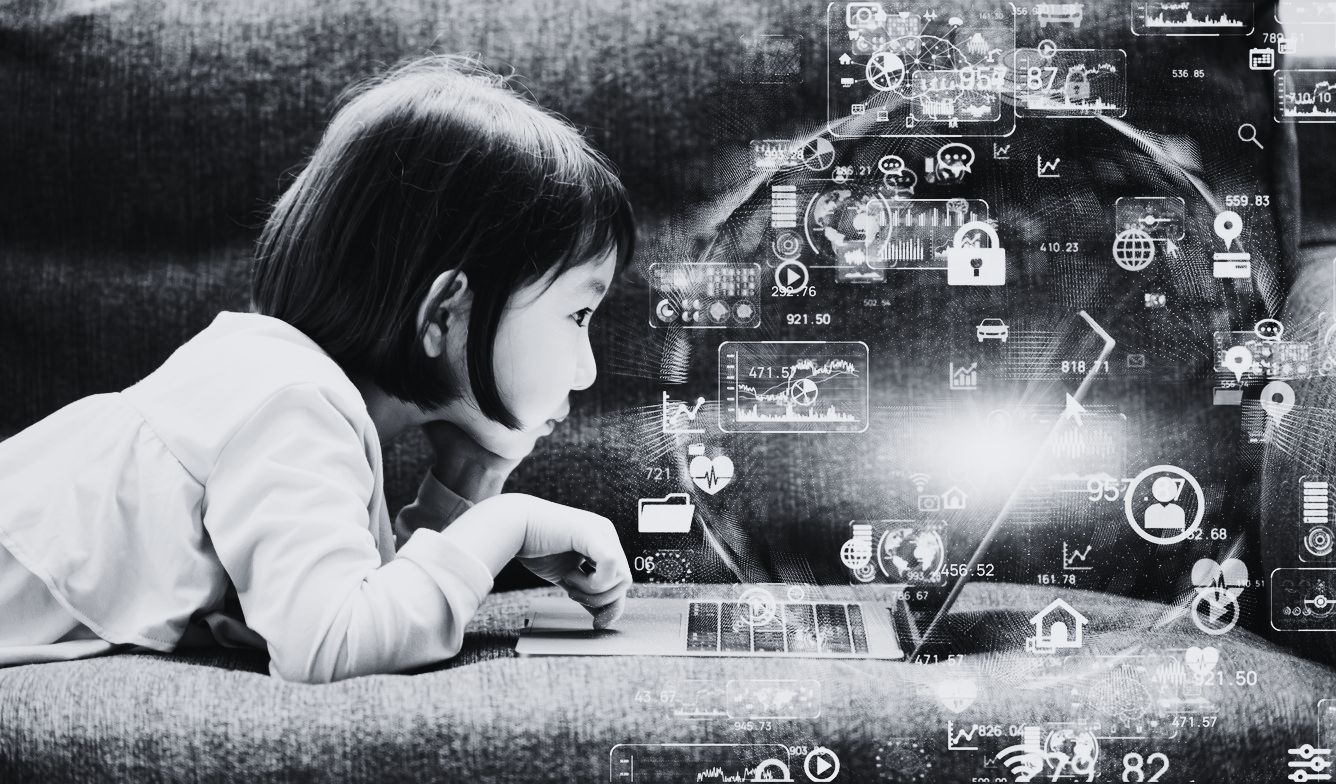Technology will not replace great teachers, but technology in the hands of great teachers can be transformational.
- George Couros
What comes next, with having more access to technology than ever before?
In this blog, we will take a look at the main EdTech trends for kids this year.
What is EdTech?
Digital technology, such as computer hardware or software, is referred to as EdTech when it is used to improve or support teaching and learning. This might be related to real items like interactive whiteboards, laptops, tablets, or translation tools. It might also be used to describe online learning management platforms or virtual reality applications. EdTech aims to encourage and support simplified teaching and learning management. Related article: Corporate LMS: How It Drives Business Success
Importance of EdTech
EdTech makes it easier for educators to instruct students effectively. For individuals who are interested in learning, it is a flexible option to achieve their goals in terms of time and money
Education technology can help with extracurricular collaborative learning, such as language or art workshops, as well as online learning that is self-directed
Additionally, EdTech is not constrained to a conventional classroom. It is advantageous to the learners who are stranded at home because of the COVID-19 Pandemic
Companies in the EdTech industry help children learn using the methods that will be most useful to them. Virtual reality and other EdTech tools enable students to explore and experiment with almost anything, even potentially hazardous science projects involving chemicals like acids and others
By simply giving them the required technology to take online classes, listen to them, and read subtitles if its difficult to understand, EdTech companies may also assist students with disabilities
By making learning and formal education more approachable, interesting, and enjoyable, EdTech companies have the ability to completely alter these fields of study. Only if EdTech companies keep up with the most recent trends in educational technology will it be possible. Lets examine this in full depth.
7 Essential EdTech Trends for Kids in 2022

Blockchain in EdTech
Blockchain technology is being used in education more and more frequently. It provides a comprehensive, open, and decentralized educational ecosystem. Blockchain technology may be used by EdTech platforms to link teachers, professionals, and students to the right courses and learning resources.
When a course fits certain defined requirements of the system, students are led to it using blockchain. Blockchain technology can be used by institutions to protect a variety of documents and data, including admissions, attendance, account statements, grades, and test results.
With the use of blockchain, students can preserve their certificates and accomplishments without worrying about losing them. EdTech currently offers one of the biggest growth investment opportunities. Even well-known universities like MIT have begun incorporating blockchain technology into their programs.
The skyrocketing value of cryptocurrencies like Bitcoin and Ethereum has been making headlines. Cryptocurrency is no longer regarded as a strange, passing technology trend that will disappear once people understand it is a mansion built on sand.
For instance, Gilgamesh is a knowledge-sharing platform based on Ethereum smart contracts. Book readers, students, and authors can get together to debate a book or other work, just like on a social media platform. The key distinction is that they are given GIL Tokens (or are otherwise rewarded) for contributing to discussions, writing, and sharing material. Then, you can use the tokens to purchase other academic eBooks. Additionally, the Gilgamesh app offers book recommendations, social media feeds, and a wallet to keep GIL tokens for interacting with other bookworms.
This means that, if you can, now is an excellent time to invest in blockchain technology.
Combining AR, VR, and XR in daily learning

Online learning makes it more possible for kids minds to stray into fantasy. The biggest challenge that EdTech companies have is keeping students actively engaged and concentrated on the subject matter. Multisensory learning is made possible by AR/VR technology, which combines tactile, kinesthetic, visual, and aural components to provide an immersive experience.
Online learning will evolve to include technologies like virtual reality (VR), augmented reality (AR), and extended reality (XR), which will result in real-world simulated learning. These advancements may also lead to virtual learning environments, which are settings where you may interact with your theories and make them real. It will assist students in keeping their attention and involvement.
Nowadays, in order to give students a firsthand experience of destructive storms, we can employ augmented reality to build a tornado and then transport the funnel right into the classroom. For instance, the SkyView app enables children to explore the universe. Anyone may use SkyView on their mobile device and aim it upward to recognize stars, constellations, planets, and even satellites.
Students can use the Froggipedia app augmented reality technology to investigate a frog internal organs.
Most teachers are unable to take their students to the Louvre or Base Camp on Mount Everest, but they may do both of these things by organizing a series of intensely immersive school excursions using Google Expeditions.
Therefore, as you can see, incorporating these technologies into pedagogies will boost efforts to encourage learning and, most importantly, provide the practical skills students might need to succeed in their life.
Multimedia mobile learning

Most parents have a device that will enhance their childs education in their pockets: a cell phone. Allowing kids to play on a phone or tablet while out doing errands or on vacation may seem like the simple solution, but incorporating learning into our mobile life actually boosts childrens skills and knowledge.
Additionally, it motivates kids to engage with their surroundings. By using these tools, children can improve their visual and spatial skills and get ready for school and workplace, both of which depend heavily on computers and other technologies. We can make learning enjoyable and eventually promote growth and learning by encouraging kids to connect their screens to the real world.
It can make sense to introduce your child to online education outside of the classroom given the growth of online learning. Educational applications can assist parents in overcoming their childs weaknesses and strengths in addition to providing a customized learning plan.
One of the top children learning applications available for young learners is ABCmouse. It was designed to assist young children learn and master a variety of skills, including letter recognition, reading comprehension, math, and more for children aged from 2 to 8.
The Quick Maths app also teaches kids in grades 2 to 6 general math concepts and helps children become familiar with numbers. It's the ideal alternative for self-improvement and for enhancing children's abilities to deal with the challenges and problems of math.
Related article:How Much Does it Cost to Develop an Educational App?
Gamification

Learning has to be fun. However, the majority of children in traditional schooling systems do not get this experience. A child who does not grasp the underlying ideas or the bigger perspective of what they are studying may find reading and math to be frustrating.
In many situations, students are systematically encouraged to simply memorize material and follow the requirements of the curriculum. Without creating the proper foundations and building blocks for comprehension and critical thinking, the school can get even more daunting as the kid advances through the grade levels and the difficulty of the courses increases.
However, knowledge can be put into practice by combining imagination, creativity, and gaming mechanics with the needed information. An interactive learning environment where participation is essential to success can be created by immersive game settings that can integrate visual, audio, and tactile modes of exchanging information with players.
Gamification offers a wide range of compelling advantages:
1. Makes it possible to participate in learning more deeply.
2. Learning becomes enjoyable and interactive, which speeds up assimilation.
3. Gamification improves active learning and better understanding.
4. It offers instant feedback.
Although mindless memorization exercises are disliked by most people, they are considered to be beneficial for remembering fundamental knowledge. The process of learning multiplication sets, however, doesnt have to be difficult. A more effective method for children to learn this fundamental math concept is shown in the game Timez Attack.
Another example is the animated ebook library Raz Kids, which incorporates extremely subtle game aspects. Many children struggle with reading throughout their school years. If the proper foundation isnt established, it could start to feel like a chore. Raz Kids is made to interactively assist kids in learning phonics and sight reading.
Related article: Why Edutainment is an Absolute Game-changer in Learning?
Digital books

Like print books, well-made ebooks can help with the development of a childs language, social, listening, and cognitive abilities. Learning from boring textbooks cant possibly be interesting in traditional classroom settings.
A digital tablet or book is not only affordable but also easy to update with the most recent information. Ebooks can also be a creative and entertaining way for kids to enjoy reading, have storytime, and get useful information. For example:
Children can understand and remember narrative details with the help of illustrations, animations, and games
Childrens understanding of characters and story developments can be improved by music
Children can learn words and broaden their vocabulary with the help of dictionaries and narratives.
Ebooks can help young readers with learning difficulties. The kids can follow along while listening to narration or use interactive elements to comprehend stories more effectively.
Sometimes digital books can encourage reluctant readers. If you want your children to learn more, then install the Maneno app. The primary goal is to inspire and appreciate your child's effort and ambition. It's possible by using a playful approach that your child finds encouraging. Because it functions and turns reading into a game, Maneno is even utilized in schools and government libraries in Denmark and Norway.
Multi-sensory classrooms

Children can remember more information thanks to multi-sensory classrooms. Incorporating a variety of sensory experiences while organizing a class is essential to ensuring that each student is interested and able to acquire the material in a way that works best for them.
With the help of cutting-edge technology, interactive whiteboards are now providing students with a multi-sensory learning environment. Using interactive whiteboards is a clever technique to engage kids fully and improve learning. They represent significant progress in educating the following generation of students.
Learning results are consistently improved by interactive whiteboards because they accommodate visual, aural, and kinesthetic learning styles. They help teachers educate students on abstract and difficult concepts in an interesting and enjoyable way. Additionally, they enable teachers to document their instructions so that they can later share them with kids for revision.
Pay attention to the interactive whiteboard apps, which can assist you with the teaching process a lot. Let's say Miro is a popular visual collaboration app with an online whiteboard. Its easy to use and allows you to create a whiteboard according to your needs. You can create a whiteboard that works for your team, add customized colors, unique fonts, and more.
You will frequently need to set up and take down whiteboards quickly, especially if you operate in a fast-paced business. A lightning-fast way to achieve this is with Whiteboard Fox.
Another digital visual collaboration app with a whiteboard is MURAL. For instance, you may quickly set up a board and operate either asynchronously or in real time. Using a template enables you to organize your session right away.
Artificial intelligence
One of the most significant ways artificial intelligence will affect education, from pre-kindergarten to graduate school, is through the implementation of higher levels of personalized learning. Through the increasing use of adaptive learning software, games, and programs, some of this is already taking place. These systems adapt to the demands of the student by emphasizing particular subjects more, going over concepts that the student hasnt learned, and overall assisting the student in working at their own pace, whatever that pace may be.
With teachers enabling the learning and providing assistance as needed, this type of custom-tailored education could be a machine-assisted solution to helping students at various levels to work together in a classroom. As AI develops over the next few decades, adaptive programs will probably just get better and more popular.
AI can not only assist teachers and learners in creating courses that are tailored to their needs, but it can also give both sides feedback on the overall effectiveness of the course. Some institutions, particularly those that offer courses online, use AI systems to track students progress and notify teachers when there may be a performance problem.
Students can learn at any time and from any location using AI systems, software, and support. In some cases, teachers may even be replaced by AI since these programs replace some forms of classroom learning. AI-powered educational programs are already assisting students in the acquisition of fundamental skills, but as these programs expand and their creators gain more knowledge, they are expected to provide students with a considerably wider range of services.
How Can PioGroup Software Help?

Maneno is an example of one of our projects. It is a reading app speaking a digital language that your children will definitely understand and like. A fascinating world that creates a connection between print and digital media that captures the attention of readers and gives them desire to read more.
Contact us if you want to create a learner management system, CRM, website, app for your business, school, university or simply to ask a question. We are always ready and happy to help. Related article: E-learning Websites: Types and Tips for Development.
To Sum Up
These EdTech market trends will help you get ready for the future of learning in 2022 and beyond, whether you are already a course creator or educator trying to improve your course, an interested learner, or even someone brand new to the EdTech industry.
For both students and teachers, EdTech assists in making learning more interesting, smart, and efficient. Using EdTech to enhance the entire learning experience is in everyones best interest.





